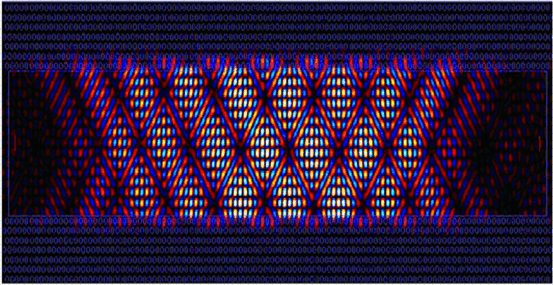|
Introduction
Features
‣
Layout
Editor
‣
FDTD Engine
‣
Cluster for FDTD
‣
Active FDTD
‣
FETD Engine
‣
FEFD Engine
‣
RCWA Engine
‣
Scripting / Optimisation
‣
GDSII Export
‣
Surface Grating Utility
Applications
Options
Publications
Download
‣
OmniSim brochure
‣
Nanophotonics brochure
Request evaluation
|
Active FDTD
Add carrier dynamics to your FDTD model
Photon Design offers the World’s first commercial active
FDTD tool adding the ability to model semiconductor gain within an FDTD engine. Now you can at last model
photonic crystal
lasers and other micro-cavity lasers realistically.
Gain models
The Active FDTD module supports two different gain models:
-
The Dynamic Gain model, in which the gain
is function of the carrier density. This model accounts for current injection, spontaneous and stimulated recombination rates.
For this model the user needs to provide gain curves (either from
experiment or simulated using e.g. Harold),
which are then fitted with our Wide-Band Gain model.
-
The Static Gain model, which does not explicitly consider a carrier density in the device but rather uses a saturable gain
model in which the gain is a function of intensity. In this case the
user can simply define the gain function as a sum of Lorentzian functions whose amplitude, position and width
can be specified.

Littrow lasing simulated in a W15 line defect constructed in an InGaAsP QW material
and electrically pumped. The simulation includes a dynamic carrier model.
Features
Dynamic Gain model:
-
Rate equation model of carriers including spontaneous recombination,
stimulated recombination, injection current.
-
Wide-Band Gain model, with automatic fitting to a set of gain
curves (g(l) at a set of different carrier densities).
-
Convergence Acceleration – normally the spontaneous lifetime is too
long to model in FDTD (would require too many FDTD time steps).
Convergence Acceleration gets the device into the correct steady state
more quickly.
Static Gain model:
-
Saturable gain model.
-
Gain function defined as sum of user-defined
Lorentzian functions.
-
Very simple to use.
-
Fully integrated into the OmniSim and CrystalWave user-interfaces.
-
Almost all features of the FDTD engine available (excluding
sub-gridding – possibly available in a future version).
-
Current injection is controlled by an Editor mask-layer, allowing you to
readily inject current anywhere you want.
-
All gain-material parameters are stored in a standard Photon Design
material database file (.mat).
-
Speed: in general the gain material is confined to a small layer – a
fraction of the total simulation volume. Therefore the module does not
significantly slow down the simulation speed.
Applications include
photonic crystal lasers and VCSELs.
Download
Active-FDTD specifications
|








